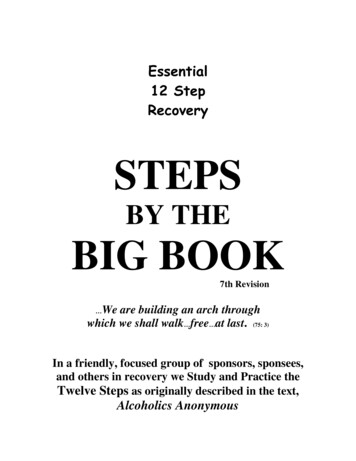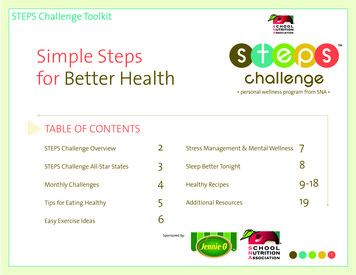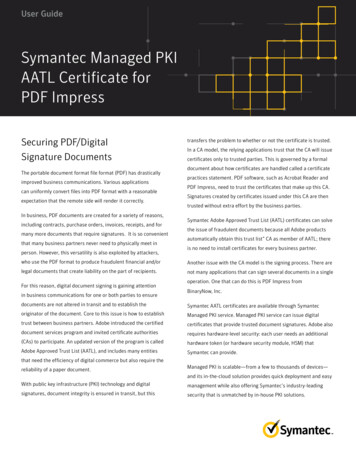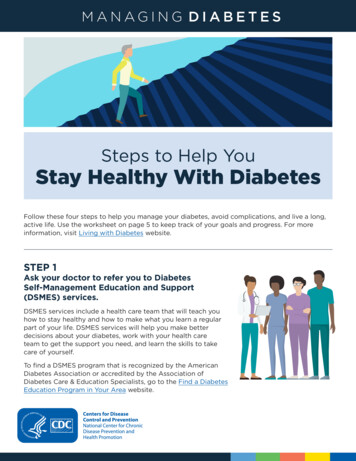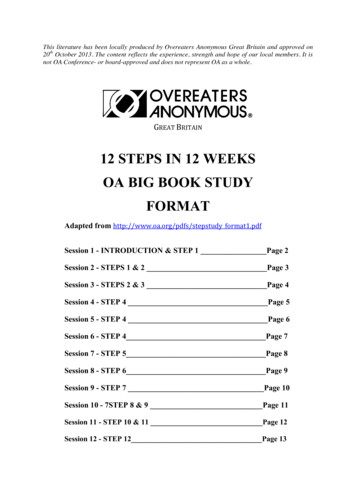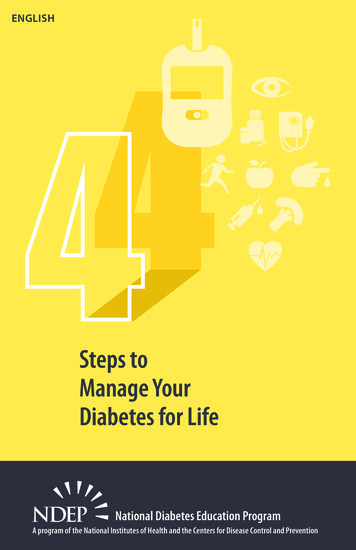
Transcription
ENGLISHSteps toManage YourDiabetes for LifeNational Diabetes Education ProgramA program of the National Institutes of Health and the Centers for Disease Control and Prevention
This booklet gives four keysteps to help you manageyour diabetes and live along and active life.ContentsStep 1: Learn about diabetes1Step 2: Know your diabetes ABCs5Step 3: Learn how to live with diabetes8Step 4: Get routine care to stay healthy11Things to remember12My Diabetes Care Record13To learn more16
Actions you can takeThe marksin this booklet show actionsyou can take to manage your diabetes. Help your health care team makea diabetes care plan that will workfor you. Learn to make wise choices for youdiabetes care each day.STEP 1:Learn about diabetes.What is diabetes?There are three main types of diabetes: Type 1 diabetes – Your body does not make insulin.This is a problem because you need insulin to takethe sugar (glucose) from the foods you eat and turnit into energy for your body. You need to take insulinevery day to live. Type 2 diabetes – Your body does not make or useinsulin well. You may need to take pills or insulinto help control your diabetes. Type 2 is the mostcommon type of diabetes. Gestational (jest-TAY-shun-al) diabetes – Somewomen get this kind of diabetes when they arepregnant. Most of the time, it goes away after thebaby is born. But even if it goes away, these womenand their children have a greater chance of gettingdiabetes later in life.1
You are the most important memberof your health care team.You are the one who manages your diabetes day by day.Talk to your doctor about how you can best care for yourdiabetes to stay healthy. Some others who can help are: dentist nurse diabetes doctor nurse practitioner diabetes educator pharmacist dietitian social worker eye doctor foot doctor friends and family mental health counselor2
How to learn more about diabetes. Take classes to learn more about living with diabetes.To find a class, check with your health care team,hospital, or area health clinic. You can also searchonline. Join a support group — in-person or online — to getpeer support with managing your diabetes. Read about diabetes online. Go tohttp://www.cdc.gov/diabetes/ndep/index.htm/Take diabetes seriously.You may have heard people say they have “a touchof diabetes” or that their “sugar is a little high.” Thesewords suggest that diabetes is not a serious disease. Thatis not correct. Diabetes is serious, but you can learn tomanage it.People with diabetes need to make healthy foodchoices, stay at a healthy weight, move more every day,and take their medicine even when they feel good. It’sa lot to do. It’s not easy, but it’s worth it!3
Why take care of your diabetes?Taking care of yourself and your diabetes can help youfeel good today and in the future. When your blood sugar(glucose) is close to normal, you are likely to: have more energy be less tired and thirsty need to pass urine less often heal better have fewer skin or bladder infectionsYou will also have less chance of having health problemscaused by diabetes such as: heart attack or stroke eye problems that can lead to trouble seeing orgoing blind pain, tingling, or numbness in your hands and feet,also called nerve damage kidney problems that can cause your kidneys tostop working teeth and gum problemsActions you can take Ask your health care team what typeof diabetes you have. Learn where you can go for support. Learn how caring for your diabeteshelps you feel good today and inthe future.4
STEP 2: Know your diabetes ABCs.Talk to your health care team about how to manage yourA1C, Blood pressure, and Cholesterol. This can helplower your chances of having a heart attack, stroke, orother diabetes problems.A for the A1C test (A-one-C).What is it?The A1C is a blood test that measures your average bloodsugar level over the past three months. It is different fromthe blood sugar checks you do each day.Why is it important?You need to know your blood sugar levels over time. Youdon’t want those numbers to get too high. High levels ofblood sugar can harm your heart, blood vessels, kidneys,feet, and eyes.What is the A1C goal?The A1C goal for many people with diabetes is below 7.It may be different for you. Ask what your goal should be.5
B for Blood pressure.What is it?Blood pressure is the force of your blood against the wallof your blood vessels.Why is it important?If your blood pressure gets too high, it makes your heartwork too hard. It can cause a heart attack, stroke, anddamage your kidneys and eyes.What is the blood pressure goal?The blood pressure goal for most people with diabetes isbelow 140/90. It may be different for you. Ask what yourgoal should be.6
C for Cholesterol (ko-LESS-tuh-ruhl).What is it?There are two kinds of cholesterol in your blood:LDL and HDL.LDL or “bad” cholesterol can build up and clog yourblood vessels. It can cause a heart attack or stroke.HDL or “good” cholesterol helps remove the “bad”cholesterol from your blood vessels.What are the LDL and HDL goals?Ask what your cholesterol numbers should be. Your goalsmay be different from other people. If you are over 40years of age, you may need to take a statin drug forheart health.Actions you can take Ask your health care team: what your A1C, blood pressure,and cholesterol numbers are andwhat they should be. Your ABCgoals will depend on how long youhave had diabetes, other healthproblems, and how hard yourdiabetes is to manage. what you can do to reach yourABC goals. Write down your numbers on therecord at the back of this booklet totrack your progress.7
STEP 3: Learn how to live with diabetes.It is common to feel overwhelmed, sad, or angry whenyou are living with diabetes. You may know the steps youshould take to stay healthy, but have trouble sticking withyour plan over time. This section has tips on how to copewith your diabetes, eat well, and be active.Cope with your diabetes. Stress can raise your blood sugar. Learn ways to loweryour stress. Try deep breathing, gardening, taking awalk, meditating, working on your hobby, or listeningto your favorite music. Ask for help if you feel down. A mental healthcounselor, support group, member of the clergy,friend, or family member who will listen to yourconcerns may help you feel better.Eat well. Make a diabetes meal plan with help from yourhealth care team. Choose foods that are lower in calories, saturated fat,trans fat, sugar, and salt. Eat foods with more fiber, such as whole graincereals, breads, crackers, rice, or pasta. Choose foods such as fruits, vegetables, wholegrains, bread and cereals, and low-fat or skim milkand cheese. Drink water instead of juice and regular soda.8
When eating a meal, fill half of your plate with fruitsand vegetables, one quarter with a lean protein, suchas beans, or chicken or turkey without the skin, andone quarter with a whole grain, such as brown rice orwhole wheat pasta.Be active. Set a goal to be more active most days of the week.Start slow by taking 10 minute walks, 3 times a day. Twice a week, work to increase your muscle strength.Use stretch bands, do yoga, heavy gardening (diggingand planting with tools), or try push-ups. Stay at or get to a healthy weight by using your mealplan and moving more.Know what to do every day. Take your medicines for diabetes and any otherhealth problems even when you feel good. Ask yourdoctor if you need aspirin to prevent a heart attackor stroke. Tell your doctor if you cannot afford yourmedicines or if you have any side effects. Check your feet every day for cuts, blisters, red spots,and swelling. Call your health care team right awayabout any sores that do not go away.9
Brush your teeth and floss every day to keep yourmouth, teeth, and gums healthy. Stop smoking. Ask for help to quit. Call1-800-QUITNOW (1-800-784-8669). Keep track of your blood sugar. You may want tocheck it one or more times a day. Use the card at theback of this booklet to keep a record of your bloodsugar numbers. Be sure to talk about it with yourhealth care team. Check your blood pressure if your doctor advises andkeep a record of it.Talk to your health care team. Ask your doctor if you have any questions about yourdiabetes. Report any changes in your health.Actions you can take Ask for a healthy meal plan. Ask about ways to be more active. Ask how and when to test your bloodsugar and how to use the results tomanage your diabetes. Use these tips to help with your self-care. Discuss how your diabetes plan isworking for you each time you visityour health care team.10
STEP 4: Get routine care to stay healthy.See your health care team at least twice a year to find andtreat any problems early.At each visit, be sure you have a: blood pressure check foot check weight check review of your self-care planTwo times each year, have an: A1C test. It may be checked more often if it is over 7.Once each year, be sure you have a: cholesterol test complete foot exam dental exam to check teeth and gums dilated eye exam to check for eye problems flu shot urine and a blood test to check for kidney problemsAt least once in your lifetime, get a: pneumonia (nu-mo-nya) shot hepatitis B (HEP-uh-TY-tiss) shot11
Medicare and diabetes.If you have Medicare, check to see how your plan coversdiabetes care. Medicare covers some of the costs for: diabetes education diabetes supplies diabetes medicine visits with a dietitian special shoes, if you need themActions you can take Ask your health care team about theseand other tests you may need. Ask whatyour results mean. Write down the date and the time ofyour next visit. Use the card at the back of this bookletto keep a record of your diabetes care. If you have Medicare, check your plan.Things to Remember: You are the most important member of your healthcare team. Follow the four steps in this booklet to help you learnhow to manage your diabetes. Learn how to reach your diabetes ABC goals. Ask your health care team for help.12
My Diabetes Care RecordHow to use the record.First read the shaded bar across the page. This tells you: the name of the test or check-up how often to get the test or check-up what your personal goal is (for A1C, blood pressure,and cholesterol)Then, write down the date and results for each test orcheck-up you get. Take this card with you on your healthcare visits. Show it to your health care team. Talk aboutyour goals and how you are doing.A1C-At least twice each yearMy goalDateResultBlood Pressure (BP) - At each visitMy goalDateResultCholesterol - Once each yearMy goalDateResult13
My Diabetes Care RecordHow to use the record.Use this page to write down the date and results of eachtest, exam, or shot.Each visitDateResultDateResultDateResultFoot checkReview self-care planWeight checkReview medicinesOnce a yearDental examDilated eye examComplete foot examFlu shotKidney checkOnce in lifetimePneumonia shotHepatitis B shot14
Self Checks of Blood SugarHow to use this card.This card has three sections. Each section tells you whento check your blood sugar: before each meal, 1 to 2 hoursafter each meal, and at bedtime. Each time you checkyour blood sugar, write down the date, time, and results.Take this card with you on your health care visits. Show itto your health care team. Talk about your goals and howyou are doing.DateTimeResultMy blood sugarbefore meals:Usual goal 80to 130*My goal:My blood sugar1-2 hours aftermeals:Usual goal below180*My goal:My blood sugarat bedtime:Usual goal 110to 150*My goal:*Your blood sugar goals may be different if you are an older adult (over 65) and have haddiabetes a long time. They may be different if you have other health problems like heartdisease, or your blood sugar often gets too low.15
To learn more:Many of these groups offer items in English and Spanish.National Diabetes Education ProgramAt CDC: 1-800-CDC-INFO (1-800-232-4636)www.cdc.gov/diabetes/ndepAt NIH: Phone: 1–800–860–8747www.ndep.nih.govDiabetes HealthSense: An online resource for living well.www.YourDiabetesInfo.org/HealthSenseAcademy of Nutrition and Dietetics1-800-877-1600www.eatright.orgAmerican Association of Diabetes rican Diabetes Association1-800-DIABETES (1-800-342-2383)www.diabetes.orgAmerican Heart Association1-800-AHA-USA1 (1-800-242-8721)www.americanheart.orgCenters for Disease Control and Prevention1-800-CDC-INFO (1-800-232-4636)www.cdc.gov/diabetesCenters for Medicare & Medicaid Services1-800-MEDICARE (1-800-633-4227)www.medicare.gov16
Department of Agriculture, U.S. Dietary Guidelineswww.ChooseMyPlate.govJuvenile Diabetes Research Foundation1-800-533-CURE (1-800-533-2873)www.jdrf.orgNational Eye Health Education onal Institute of Diabetes and Digestive and KidneyDiseases National Diabetes Information govNational Kidney Disease Education Program1-800-860-8747http://www.nkdep.nih.gov/17
National Diabetes Education ProgramFor more information call 1-800-CDC-INFO(1-800-232-4636) TTY 1-888-232-6348Or visit www.cdc.gov/diabetes/ndepThe U.S. Department of Health and Human Services’National Diabetes Education Program (NDEP) is jointlysponsored by the Centers for Disease Control andPrevention (CDC) and the National Institutesof Health (NIH) with the support of more than 200partner organizations.Martha M. Funnell, MS, RN, CDE of the MichiganDiabetes Research and Training Center reviewed thismaterial for accuracy.*** (language) translation provided by the Centers forDisease Control (CDC) and Prevention Multilingual Servicesand reviewed by ***The NIDDK prints on recycled paper with bio-based ink.NDEP-XXXRevised March 2016CS259466
health care team. Check your blood pressure if your doctor advises and keep a record of it. Talk to your health care team. Ask your doctor if you have any questions about your diabetes. Report any changes in your health. Actions you can take Ask for



